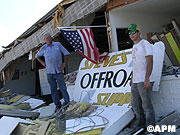Audio
Photos
| |||||||||||||||||||||||||
 |
| Grain barges heading down the Mississippi may have problems getting through to the Gulf ports. (MPR photo/Erin Galbally) |
Worthington, Minn. — Katrina's impact on midwest farmers will depend on how long the cleanup takes. The sooner the gulf ports reopen the better. Most are located on the Mississippi River. University of Minnesota Applied Economics Professor Jerry Fruin says one bit of good news is that the ports generally are outside the worst hit storm areas.
"Most of our grain export elevators are on the river to the north and west of New Orleans, but they are located below Baton Rouge," says Fruin. "It would appear that they would have sustained wind damage, but probably the flooding would not be a particular concern."
That means midwest barges probably will be able to reach the elevators relatively soon.
The real problem is the 100 mile or so stretch of the Mississippi River between the grain elevators and the Gulf of Mexico. Ocean freighters travel the water to load and unload. Fruin says the channel must be carefully checked to make sure it's still deep enough for the big boats. Debris may have washed in. It's even possible the channel shifted. Fruin says it takes people and money to check the river.
Those sorts of resources are scarce right now.
The immediate concern is to help people. Fruin says as necessary as the gulf ports are to farmers and the nation's economy, they may have to wait in line for help.
The disruption comes as midwest corn and soybean fields are ripening. Harvest will begin in a few weeks. Fruin says opening the ports by then is crucial to farm exports.
"September and October are our two largest months for these exports. So the only good news is that it happened just before the big push came, so we have a little while to prepare for it," says Fruin. "But on the other hand we're rapidly approaching the time when we would normally be moving an awful lot of corn and soybeans into export channels."
If the ports are closed when harvest begins, farmers and grain elevators must look at alternatives, like rail or truck. Minnesota Corn Growers Association President Gene Sandager says the gulf ports are the single biggest destination for Minnesota grain, but other locations are also important and available.
"It can go out to the western ports, through Seattle," says Sandager. "We do have some grain that does goes up through Duluth. Canada has been a player in purchasing our grain. We also have the option of rail, that takes it into Houston."
The problem is price. Sandager says rail is five times the cost of river barge. He says another headache caused by the hurricane are fuel costs.
Diesel and gasoline prices had been climbing steadily even before the hurricane struck. The storm shut down pumping platforms and refineries, causing another sharp rise in fuel prices. That means it will cost farmers much more to run their combines, tractors and trucks at harvest time, eating into narrow profit margins.
Still Sandager says state farmers may be better able to withstand the recent economic jolts compared to past crises.
A big factor are alternative fuels. Two more ethanol plants are expected to begin production by year's end. When they start, it will mean nearly 20% of Minnesota's corn goes into making the fuel. That's corn that doesn't have to be shipped out of state. Profits unrestrained by hurricanes or ships.




